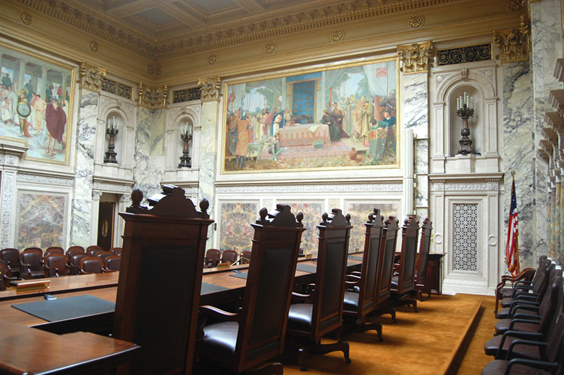Headlines
100 years later, Wisconsin Supreme Court murals still tell stories
Madison, Wisconsin - June 15, 2015
 |
| Justices of the Wisconsin Supreme Court have a view of three of four Albert Herter murals while hearing oral argument in the Supreme Court Hearing Room in the state Capitol. |
One hundred years ago this week, prominent American artist Albert Herter (1871-1950) slipped out of Madison without saying goodbye to the people who had hired him to paint murals for the Wisconsin Supreme Court Hearing Room in the new state Capitol.
The state Capitol Commission’s Lew F. Porter, who helped supervise much of the Capitol’s construction from 1906 to 1917, didn’t even get a chance to thank Herter in person for his contribution to what is now a national landmark.
But Herter left an indelible mark – four massive paintings, which are recognized among his best mural work and among the most impressive artwork in the Capitol. Each mural measures roughly nine feet high by 18 feet six inches wide, and symbolizes a source of Wisconsin law – Roman civil law, English common law, federal law, and territorial law.
“The Signing of the Magna Carta” representing the influence of English common law, takes on special significance with the 800th anniversary of the real-life event, which occurred on June 15, 1215. Curiously, Herter completed work within days of what would have been the 700th anniversary of the signing of Magna Carta.
The fact any of the murals made it into the second-floor hearing room was unlikely enough, as several Supreme Court justices preferred that portraits of justices remain in their traditional location behind the bench. The fact Herter was the artist, is the result of several twists of fate.
The Debate
It’s possible that Herter wanted to get out of town simply because his work in Madison was done. Or, he may have had enough of trying to please Supreme Court justices who wanted control over everything from the posture of the painted historical figures, to exactly where and how the murals would be displayed.
The Wisconsin State Capitol Historic Structure Report, published in six volumes between 1995 and 2005, sets the stage (book one, chapter eight):
“The complicated and protracted story of the Wisconsin Supreme Court murals involved three different artists (one of whom perished on the Titanic), justices who needed to be convinced of the desirability of murals in the hearing room and an architect who was determined to implement his scheme for the space. The justices, accustomed to portraits of former justices on the walls in the hearing room of the previous capitol, wanted to hang the portraits in the new hearing room…”
Ultimately, Porter and Capitol architect George B. Post won out through persistence, persuasion, and perhaps most effectively, strategically well-timed delays in asking the Court for direction. Herter’s murals top the walls of the hearing room with colors carefully selected to complement the book-matched marble veneer of the walls below.
As a result of Herter’s success, portraits of former Supreme Court chief justices ended up on the walls of the hearing room vestibule, where they are still displayed today. As the number of deceased justices has increased over the years, portraits of justices have overflowed into the hallways outside justices’ chambers and administrative offices on the ground floor of the Capitol.
The Artist(s)
Herter’s German-born father was “a dominant member of the influential-and immensely successful-New York firm of decorators, Herter Brothers,” according to Albert Herter’s biography on the National Academy’s website.
Herter studied at Harvard, in New York and Paris, and made Paris his base with his wife Adele McGinnis Herter from 1894 until 1898, when they returned to the United States. Although he was recognized as an easel painter, “concentrating on portraits and flower still lifes, Herter was more dedicated to mural painting, a specialization he began early in his career,” according to the Academy, previously known as the National Academy of Design.
Herter’s best-known mural, and perhaps his most personal work, is on display inside Gare de l'Est. a Paris train station. Le Départ des poilus, août 1914 (Departure of the Infantrymen—August 1914) portrays French soldiers at the station being seen off by their families as they head to battle during WWI. Herter’s eldest son, Everit, who was killed in action, is portrayed at the center of the scene; Herter and his wife are portrayed in the scene at opposite edges of the mural.
Herter murals are also prominently displayed in the Massachusetts House of Representatives (Milestones on the Road to Freedom, dedicated in 1942) and in the Connecticut Supreme Court Hearing Room (The Signing of the Fundamental Orders of the Constitution 1638-39, and An Allegory of Education, bothinstalled in 1913).
In creating the Wisconsin Supreme Court murals, Herter is believed to have used studio space at both his business, the textile design firm, Herter Looms in New York City, and at “The Creeks,” his meticulously designed East Hampton, Long Island estate. The murals arrived in Madison, and work began on installation at the Capitol on May 25, 1915, The Racine (Wisconsin) Journal-News reported on that day.
“The pictures cost the state $28,000. Francis D. Millett, who was the first engaged to make the paintings for the Supreme court room, lost his life in the sinking of the steamship Titanic before he could begin the pictures,” the Journal-News reported.
Given the scale of the project, installation apparently went quickly. “The signing of the Constitution,” representing federal law, was the first of the murals installed above the Supreme Court bench. By June 5, The Daily Northwestern of Oshkosh reported with a photo that “The Trial of Chief Oshkosh Before Judge Doty,” had been installed on the hearing room’s south wall. By June 9, 1915, Herter was on his way back to New York.
After Millett’s demise aboard the Titanic, the commission had also attempted to hire painter Barry Faulkner, who had Post’s support.
“However, the Executive Committee rejected Faulkner on 17 May 1912, because his proposed fee of $32,000 exceeded what the commission wanted to spend,” according to the comprehensive report.
One account of events indicates that Faulkner later agreed to lower his fee, but in the meantime, Herter accepted a contract on Jan. 30, 1913. Another account indicates that Faulkner asked to have his proposal withdrawn.
The Details
Although Millett did not survive, he had created drawings and may have helped shape the direction of the project. Research done in compiling the comprehensive report shows Millett wrote then-Chief Justice John B. Winslow (1851-1920) to suggest “the themes should be wider in interest than any incidents of local history and should be selected in order to show how law is based on accumulated experience on record and tradition.” Winslow served on the Court from 1891 to 1920 and as its chief justice in both the second and third state Capitols, from 1907 to 1920.
“Justice William H. Timlin criticized Millet’s ideas as ‘strained, farfetched, fantastic and small,’” according to letters cited in the 2004 comprehensive report. Several of Timlin’s own suggestions, including “The Trial of Christ Before Pilate,” and “The Signing of the Constitution of Wisconsin” were rejected. However, Timlin’s idea of depicting “The Signing of the Magna Carta” prevailed with support of the Capitol Commission.
In reviewing Herter’s drawings of what eventually became “The Signing of the Magna Carta,” justices asserted their preferences, and Herter ultimately complied with specific changes. At Winslow’s prompting, Hereter adjusted the apparent demeanor of Stephen Langton, the Archbishop of Canterbury.
Winslow wrote: “His attitude in the sketches gives the impression that he is humbly petitioning for something. While that was nominally the fact, I understand that he was in truth stoutly insisting on the king’s signing the charter and was conscious that he had behind him the power to make his insistence good.”
Justice Roujet D. Marshall (1874-1922) successfully urged Herter to move the figure of Pandulph, the Pope’s representative at Runnymede, “a little further to the right” of the king to show protest that the king would accept the barons’ demands for rights against plundering and arrest without cause.
The Murals
Each mural stands out for its own qualities, but Magna Carta quickly drew praise.
In 1919, the official guide and history of the Capitol, published by Christian A. Holst, Madison, recognized “The Signing of the Magna Carta” as the best of the four murals:
“… The groups are very happily disposed. The painting is the finest of the four as to picturesqueness of setting, as to composition, and as to the quiet expressiveness of king and rebels. Glimpses of the still waters and verdant fields of the Thames valley are seen behind the
tent...”
The late Chief Justice Roland B. Day (1919-2008), who described the murals and their meaning for an outreach-education project in 1997, recognized Herter’s murals as the most striking objects in the hearing room. Herter’s selection of colors complements the room’s walls and columns of marble from Germany, Italy, France and Maryland, Day wrote.
“The Trial of Chief Oshkosh,” which has the strongest historical tie to Wisconsin represents the influence of territorial law. The mural portrays Chief Oshkosh on trial before a federal Judge for the slaying of a member of another tribe who had killed a Menominee in what is described as a hunting accident.
“It was shown that under Menominee custom, relatives of a slain member could kill his slayer. Judge James Duane Doty held that in this case territorial law did not apply,‘ Day wrote. Day quoted Doty: “ . . it appears to me that it would be tyrannical and unjust to declare him, by implication, a malicious offender against rules which the same laws presume he could not have previously known...”
“The Signing of the American Constitution,” above and behind the bench, symbolizes federal law; “The Appeal of the Legionary to Caesar Augustus,” located on the wall opposite the bench, symbolizes Roman civil law.
Each mural has its own character and characters, but none likely captures events as they actually appeared.
For example, Thomas Jefferson appears in “The Signing of the Constitution.” Jefferson was actually in France when the Constitution was signed on Sept. 17, 1787 in Philadelphia. The comprehensive report indicates Jefferson was mistakenly portrayed at the scene. Day wrote that Jefferson was painted into the mural because of his strong influence on the principles behind the document.
Over the decades, colors in the murals faded, and several attempts to improve things over the years made long-term restoration efforts more difficult. In 1998, in preparation for a full renovation of the Hearing Room as part of a larger Capitol restoration project, paint samples were analyzed to determine the original colors used by Herter. Repairs were made, and the newly refurbished murals were again unveiled in 2001, along with other work on the East Wing.
The Model Son
“The Signing of the Magna Carta” also has a slightly quirky tale – the boy depicted holding the dog in front of the table in the mural was modeled by the artist’s son, Christian Herter (1895-1966).
Christian Herter grew up to be a notable figure in real life, as well. He served as governor of Massachusetts from 1953 to 1957 and as U.S. secretary of state under President Dwight D. Eisenhower from 1959 to 1961. He previously had served in a variety of elected and appointed positions.
His appointment by Eisenhower was widely heralded at the time, and his death on Dec. 31, 1966, was front-page news in many American newspapers, including The Capital Times of Madison. The Capital Times ran a photo of Christian Herder’s boyhood image, cropped from the hearing room’s “The Signing of the Magna Carta.”
Although Herter left Madison before Porter could thank him personally, Porter later wrote in appreciation: “…Every one with whom I have talked, including several members of the Supreme Court and some of the Capitol Commission, have expressed themselves as being delighted with your work. It certainly adds greatly to the room, and I feel sure will be universally appreciated.”
More information about the Wisconsin Supreme Court murals can be found at:
National Historic Landmark Nomination Form
U.S. Department of the Interior, National Park Service, June 10, 2000
The Wisconsin State Capitol Historic Structure Report
The National Academy(Albert Herter biographical information)
History of the Magna Carta – a Joint Project
Contact:
Tom Sheehan
Court Information Officer
(608) 261-6640

